Historic Background and Reason For Prescribed Burning
After the glaciers retreated over 9,000 years ago fires swept across much of North America, set by Native Americans and occasionally started by lightning. Fire created the vegetation and wildlife Europeans found during settlement and westward expansion.
Europeans disdained and feared fire. They suppressed it while introducing many invasive exotic plants. This has created a forest landscape of large trees with an understory of shade-loving exotic vegetation in place of former savannas.
Europeans didn’t understand nor appreciate varied ecosystems like prairies. Even as farmers and ranchers used the open lands for crops and grazing, little did they realize the importance of fires. Fires sweeping across prairies invigorate grasses and wildflowers while killing any brushy plants that try to move in.
What Fire Favors:
- It tends to favor grasslands over forests.
- It tends to create and maintain savannas.
- It tends to favor native over exotic vegetation.
- It tends to favor some native tree species over others. In general, trees that produce large nuts, such as oaks, hickories, and walnuts tend to be fire-resistant or dependent. Trees that create small seeds, such as elms, ashes, and maples tend to be fire-tender. The impact of repeated fires shifts dense woodlands to savannas dominated by oak and hickory and, in drier areas, prairies.
- A cool forest burn
- Burns open up sunlight for spring ephemerals.
Impact of Prescribed Burns on Prairies
Prescribed burning tends to:
- Remove insulating dead grasses, allowing the sun to warm the soil. This, favors warm season prairie plants.
- Create ash, which enriches the soil by recycling nutrients.
- Stimulate native species.
Note: burning in fall tends to favor forbs (wildflowers) while early spring burning favors prairie grasses.
Safety for Persons Conducting Burns
- Have a fire permit and adhere to its requirements.
- Wear natural fiber clothing, leather gloves, and sturdy boots.
- Understand fire behavior. See below.
- Stay out of unburned fuel and know where safe locations are. Safe locations include already burned areas, paved or gravel surfaces, and mowed lawns.
- Understand a clear burn plan as presented by the coordinator and follow directions.
- Be aware of where all people are during the burn.
- Have a cell phone with the number of the fire department programmed in.
- Have appropriate fire management tools handy and a first aid kit.
- Know about how to survive should one be “caught” by a fire.
- Be aware of “defense in depth”. (Have a second location to hold a fire should it get out of control.)
- Mentoring younger fire managers.
Fire Behavior
Fires behave based on three factors: Fuel, Topography, and Weather.
Fires tend to burn faster:
- Upslope rather than on the flat or downhill.
- With the wind.
- With low humidity.
- With dry fine fuel.
Knowing these tenets of fire behavior helps plan burn strategy. For example, if the humidity is low, wind is moderate, and fuel is dry and fine it may be prudent to burn slowly into the wind or downslope. However, if the humidity is high and the wind is low it is likely prudent to burn with the wind, after creating a safe firebreak. These assume flat terrain.
- Rich moves fire to new fuel.
- Burn Against Wind
A skilled person planning a prescribed burn considers all these factors before striking a match and conducts the fire most prudently.
Conducting a prescribed burn is one of the most effective ways to restore a semblance of America’s traditional vegetation.
- Pathways and prairie grasses.
- Stand out of fuel.
- Dark soil warms the earth.

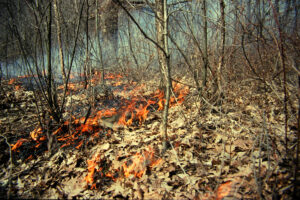
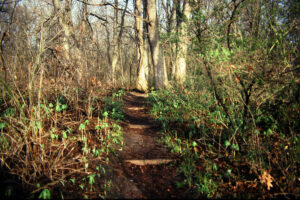
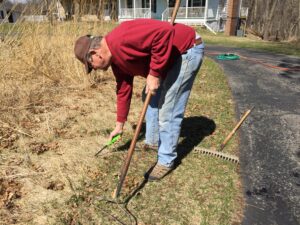
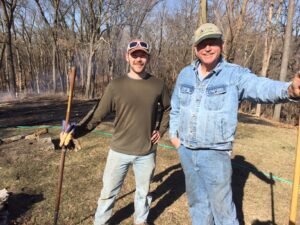
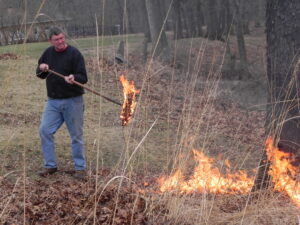
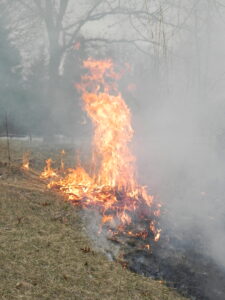
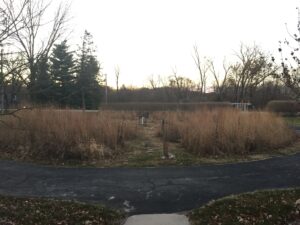
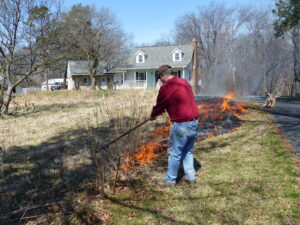
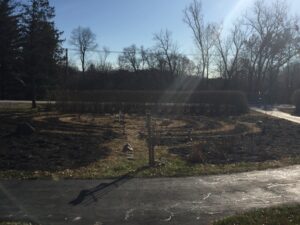

Will spring burning effect wild asparagus?
Doug, it will depend on when you burn. Early burns likely not as the asparagus is not up yet.